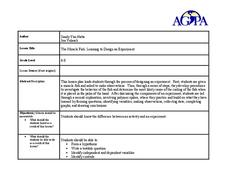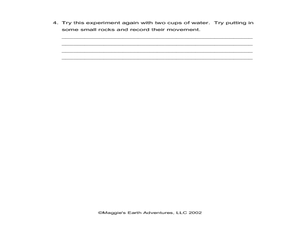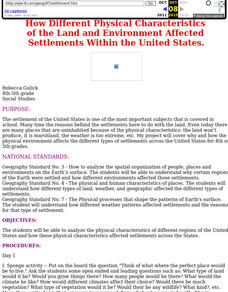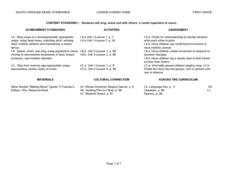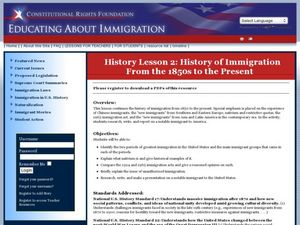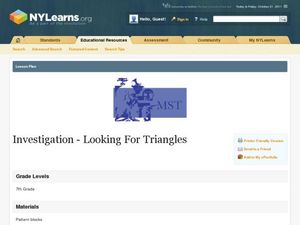Curated OER
Pecans and Peanuts
In this pecans and peanuts worksheet, students complete a Venn diagram comparing pecans and peanuts with the labels on the Venn diagram. Students complete 1 Venn diagram.
Curated OER
Changing Images of Childhood in America: Colonial, Federal and Modern England
Students compare and contrast maps of New Haven, Connecticut from today and the past. After taking a field trip, they draw sketches of the types of architecture and discuss how the buildings have changed over time. They read journal...
Curated OER
Who Do You Think You Are?
Learners discuss, and record significant events and people in their lives. They discover the reality of the past and recognize and attempt to project the future as a result of knowledge gained. They recognize and realize their...
Curated OER
The Growth Of A City
Pupils define what a city is. They investigate the top 10 - 15 most populated cities. SDescribe factors influencing the location and growth of urban sites. They site examples of cities that have grown with different models of urban...
Curated OER
The Miracle Fish: Learning to Design an Experiment
Young scholars develop procedures to explore the behavior of fish. In this scientific experiment lesson students from a hypothesis, write a question, identify different variables and controls in their experiment.
Curated OER
I Think I Forgot Something!
Young scholars examine human health by reading a children's book in class. In this breakfast lesson, students identify the importance of starting the day with a good, nutritious meal. Young scholars read the book I Think I Forgot...
Curated OER
Land of No Trees
For this Land of No Trees worksheet, students read a passage titled "Land of No Trees" about the Arctic Tundra and complete an experiment and short answer questions about it. Students complete an experiment with a plastic container,...
Curated OER
Living or Nonliving
Third graders brainstorm a list of the characteristics of living and nonliving organisms. Individually, they find four nonliving and living items and the characteristics that make them fit into one of the categories. To end the lesson,...
Curated OER
Land and Environment Affected Settlement
Students analyze the physical characteristics of different regions of the United States and how these physical characteristics affected settlements across the States.
Curated OER
Life Cycle of a Frog
Students work together to explain and illustrate the life cycle of a frog.
Curated OER
All About Me: My Senses
Pupils explore the world around them and identify their five senses and the parts of their bodies that are associated with each sense.
Curated OER
Frog Metamorphosis
Students play 20 Questions with animal characteristics and then view an animation of how a tadpole changes into a frog. They consider the importance of camouflage to frogs and write out the story of a frog from tadpole to adult.
Curated OER
What Is Hunger and Who are the Hungry?
Students investigate the purpose of food and how the body needs it for survival. The social problem of hunger is introduced and then researched looking for its causes and some solutions. There is background information in the lesson for...
Curated OER
Discovering Your Community
Learners focus on the origins of the families that make up their community by exploring their family's origins through themselves, parents, and grandparents. Students create a map marked with family origins for the class.
Curated OER
Singing And Making Rhythm
First graders engage in a lesson that emphasizes the use of music to form a rhythmic beat that incorporates singing. They create a song in freestyle and some of them create a song. Students are assessed at using hand movement to track...
Curated OER
Water and Ice
Students examine how water changes state, from a liquid to a solid. In this water lesson students study the water cycle and how temperature and pressure effect it.
Curated OER
History of Immigration From the 1850's to the Present
Eleventh graders study the history of immigration from 1850 to the present. In this American History lesson plan, 11th graders compare the 1924 and 1965 immigration acts and give a reasoned opinion on each. Students research,...
Curated OER
A New Society Project
Ninth graders examine the social and political movements of the Gilded Age and Progressive Era. In this American history lesson, 9th graders work in groups to form their own society and laws. Students make a diagram of their town and...
Curated OER
Immersion Presents Monterey Bay
Students study Monterey Bay. In this Monterey Bay instructional activity, students create a model of upwelling around Monterey Bay. Students simulate surface water movement relative to prevailing winds.
Curated OER
Looking For Triangles
Students solve problems with triangles. In this geometry instructional activity, students analyze shapes to find different triangles. They name the shapes created by putting triangles together.
Curated OER
Descriptive Writing
Students practice descriptive writing. In this unique writing lesson, students hear a story about a mitten. Then three grade levels come together to first, create a mitten on KidPix; second, describe the designed mitten; and third, try...
Curated OER
Plants
Second graders examine the characteristics of plants. As a class, they brainstorm a list of items plants need in order to survive. In groups, they complete various experiments in which they discover the functions of the parts of the plant.
Curated OER
Christmas Tree Farming in Ontario
Students realize that Christmas trees produced in Ontario are a field crop that is harvested annually. They find out that Christmas tree farming is important to the economy and the environment of our province.
Curated OER
What are Hunger and Malnutrition and Who Are the Hungry?: Ethics, Food, Global Cultures
Pupils explain the consequences of hunger and malnutrition, to know that we need many different foods and to know who is hungry and malnourished in the world.




